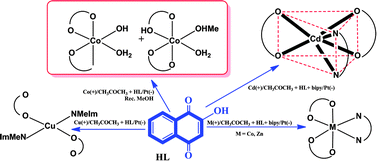Electrochemical synthesis and structural characterization of homoleptic and heteroleptic cobalt, nickel, copper, zinc and cadmium compounds with the 2-hydroxy-1,4-naphthoquinone ligand†‡
Abstract
The electrochemical

* Corresponding authors
a
Departamento de Química Inorgánica, Universidad de Santiago de Compostela, Santiago de Compostela, Spain
E-mail:
josearturo.garcia@usc.es
Fax: +34 981 547102
b Centro Singular de Investigación en Química Biolóxica e Materiais Moleculares(CIQUS), Universidad de Santiago de Compostela, 15782-Santiago de Compostela, Spain
The electrochemical

 Please wait while we load your content...
Something went wrong. Try again?
Please wait while we load your content...
Something went wrong. Try again?
I. Casanova, A. Sousa-Pedrares, J. Viqueira, M. L. Durán, J. Romero, A. Sousa and J. A. García-Vázquez, New J. Chem., 2013, 37, 2303 DOI: 10.1039/C3NJ00227F
To request permission to reproduce material from this article, please go to the Copyright Clearance Center request page.
If you are an author contributing to an RSC publication, you do not need to request permission provided correct acknowledgement is given.
If you are the author of this article, you do not need to request permission to reproduce figures and diagrams provided correct acknowledgement is given. If you want to reproduce the whole article in a third-party publication (excluding your thesis/dissertation for which permission is not required) please go to the Copyright Clearance Center request page.
Read more about how to correctly acknowledge RSC content.
 Fetching data from CrossRef.
Fetching data from CrossRef.
This may take some time to load.
Loading related content
